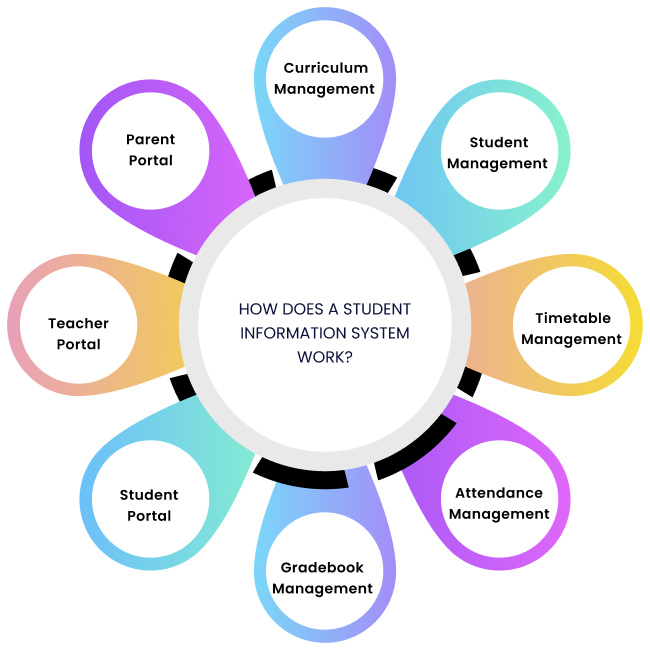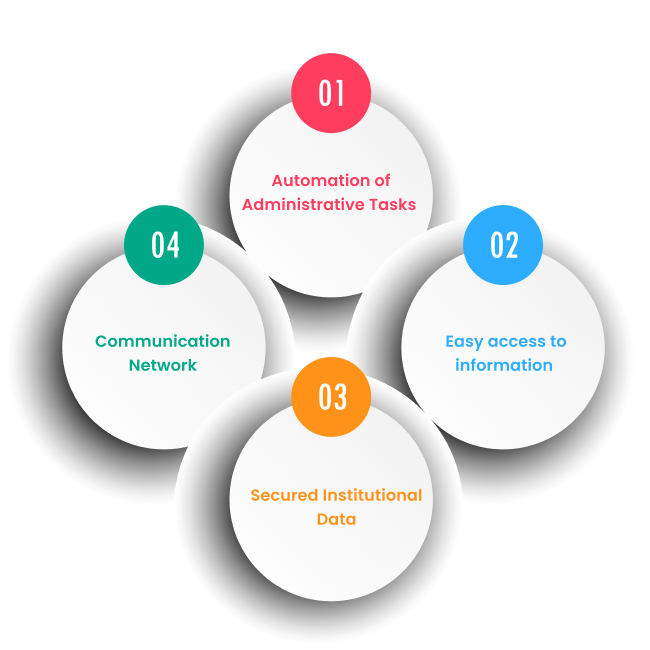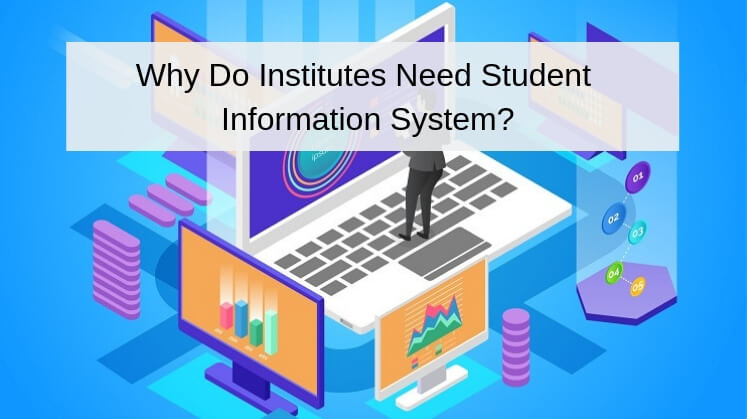04, May 2024
Facilitating high-quality education and ensuring institutional success simultaneously are the primary objectives of schools and colleges. Despite strategic measures and a team of experts, institutes falter and encounter difficulties due to a lack of appropriate measures.
The solution lies in the edu-tech revolution that has provided us with advanced tools such as the student information system (SIS). Institutes succeed at improving various practical administrative problems and accomplishing organisational objectives.
What is a student information system?
A student information system is a software solution that allows educational institutes to store, collect, manage, and share student data conveniently. In fact, it acts as a central record management system that streamlines routine academic and administrative activities.
Moreover, SIS is a perfect substitute for legacy systems, which require staff and stakeholders to handle documents manually. In effect, it helps to automate tedious academic and administrative processes, making them more efficient and hassle-free.
Also, a centralised data storage system enables stakeholders to access information quickly without sorting through files or databases. Teachers can use the software to identify students’ learning needs and resolve their queries accordingly.
How does a student information system work?
Student information provides a digitalized platform through which institutes can automate their core functions, helping to manage various institutional processes. Consequently, it accelerates administrative and organisational tasks. But that’s not all; a lot goes into SIS, so it is only fitting to take an in-depth look at its functionality.

1. Curriculum Management
A well-structured system is necessary to shape the way students learn and guide them accordingly to gain knowledge and skills. Although the syllabus acts as a crucial learning tool, the curriculum plays a significant role.
The curriculum establishes the learning outcomes, standards, and capabilities that students must demonstrate by the term's end. Furthermore, curriculum management, or programme management, points out the learning goals as per the courses.
That is where SIS proves to be a useful tool, as it helps execute the following:
- Streamline the course or programme structure into action plans.
- Identify the courses that institutes must add to the curriculum.
- Distribute and implement the courses as per different classes and complete the programme structuring.
2. Student Management
Teachers and administrators have to deal with massive student data throughout the academic cycle and ensure its proper maintenance. Moving beyond manually intensive or file-based systems is imperative, especially when work keeps piling up.
In fact, the admin and staff can store student data on a digital platform, such as online student profiles, through a student management system. They can fill out crucial student information, including birth date, course/programme, grade/semester, etc.
Likewise, they can organise and simplify different aspects of the enrollment process, such as executing tuition fees by linking students’s profiles with payment gateways. Also, the admin staff can send and retrieve files or information with just a few clicks.
They can seek out specific information by filtering student data, helping to save time that team members would otherwise have to sort through the whole system. For instance, they can check the attendance or fee payment details of particular students.
Simplify Institute Tasks: MasterSoft's Student Management System
3. Timetable Management
What if the classes for two separate subjects that students have chosen have been assigned during the same time and day? Chaos and confusion will ensue, worrying both students and teachers.
It relates to the worst-case scenario that institutes strive to avoid, and the responsibility rests on the administrative team. That is why they prioritise timetable management by figuring out the classes according to faculty availability.
At the same time, they must cater to the learner’s requirements; hence, they can create and share the timetables online. Besides, having a ready-made structure enables the admin to display and inform the class details in advance.
Additionally, users can create the schedule for recurring classes in just a few minutes and organise different versions of the timetables.
4. Attendance Management
Noting or recording students’ attendance regularly is a repetitive practice that teachers need to conduct, regardless of how tiresome it gets. Moreover, recording and maintaining accurate student attendance is significant.
Carrying out the attendance-taking process manually is a time-consuming process and can lead to unintended errors. However, teachers and administrators can track attendance in real-time with a student information system.
What’s more, they can store attendance data on the online platform, enabling stakeholders to access it remotely. More importantly, parents can check and track the attendance of their respective children. As a result, the tool helps keep parents updated regarding their ward’s school activities.
5. Gradebook Management
Waiting until the parents or students can get the report card in their hands to see how the latter has performed is an outdated approach. Moreover, teachers need to take out time specifically to calculate grades and develop hard copies of grade books.
The next step involves sending the gradebooks to the principal to sign or get the institute’s official stamp. However, teachers and administrators can avoid such a lengthy process by using SIS, which helps create multiple gradebooks digitally.
Additionally, they can add dates and comments and make corrections upon review of exam answer sheets with only a few clicks. Also, teachers and administrators can check the gradebook history with the help of the gradebook management feature.
Furthermore, teachers and administrators can complete the calculations automatically and generate multiple average values, including class and student averages. Also, adding students subsequently along with their grades is easy.
6. Student Portal
Teachers and administrative staff act as the single source of contact for all school-related information. Hence, students rely on them to know all the recent developments when it comes to exams, classes, scholastic events, etc.
Therefore, faculty and institute team members must make extra effort to notify students about important updates. Meanwhile, students can obtain the necessary information with the help of SIS’s student portal in the following ways:
- Students can view their online profiles by logging into the student portal of SIS.
- They can check their grades and assessments.
- Advanced tools like MasterSoft’s SIS enable students to connect with their teachers and peers.
10 Great Benefits Of Implementing Student Information System (SIS)
7. Teacher Portal
Ensuring students progress throughout the academic session and achieve learning outcomes is central to the teacher’s duties. On top of that, they must carry out administrative tasks related to students’ attendance, exams, and results.
Therefore, it becomes exhausting and monotonous without a more efficient mechanism, and that is where SIS’s teacher portal is useful. In fact, teachers succeed at executing the following functions via the teacher portal:
- Teachers can execute various teaching-related vital tasks.
- They can view the student profiles that contain all student-related information.
- They can create grade books and update them according to individual student performance in tests.
- Tracking student attendance and generating reports is another crucial benefit.
- The teacher portal provides a platform to connect with administrators, other teachers, and students.
8. Parent Portal
Creating ideal scenarios at school and home is imperative to boost student learning and parental involvement. Besides, parents are eager and anxious about how their child does in school.
That is where they can use SIS’s parent portal, which provides a platform to establish and maintain connectivity between parents and the institute. Therefore, parents get personalised accounts, giving them access to their children’s academic activities.
Parents can view their children’s attendance records, assessments, grades, and fee payment invoices.
Advantages of the Student Information System

1. Automation of Administrative Tasks
The administrative department and faculty no longer need to spend time on time-consuming administrative activities. The student information system automates core institutional activities, including enrollment, helping to save time and effort.
2. Easy access to information
Teachers, students, administrators, and parents can access information conveniently through dedicated portals. For instance, they can access timetables, assessment notices, grade updates, attendance records, etc.
3. Secured Institutional Data
Role-based access and other security features protect sensitive information, including student records, contact details, financial records, etc.
4. ommunication Network
All stakeholders can communicate with each other with the help of the communication mediums that come with all the portals.
Bottom Line,
A student information system is a modern educational solution that accelerates different institutional operations. It comes with easy-to-navigate functionality that enables institutes to store, manage, and share student-related information.
In addition, it helps improve core operations by tracking metrics such as enrollment trends, performance progress, and retention rates.
Simplify your faculty hiring process with MasterSoft’s faculty management system.
Mobile: 08448010216
Email: janki.somani@iitms.co.in













